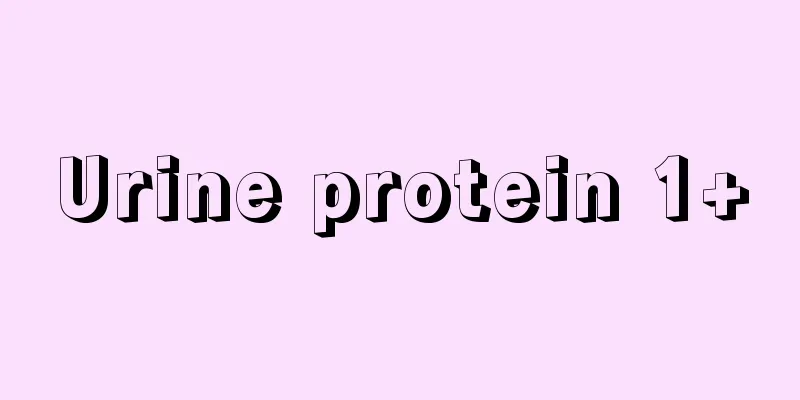Urine protein 1+

|
Normal people's urine does not contain protein. Once protein is found in the urine, it means that there is a problem with your health. This situation is mainly related to factors such as high-protein diet, excessive fatigue, cold and fever. It may also be a precursor to illness. You should actively seek medical treatment to avoid increasing the burden on your body and affecting your health. High urine protein refers to the high protein content in the urine. The protein leaks into the urine and is excreted from the urethra to form proteinuria. The higher the urine protein, the worse the kidney filtration function, which is an important indicator to measure kidney function. Under normal circumstances, human urine contains no protein or only trace amounts of protein. However, when the kidneys are diseased, the protein that circulates in the blood "slips through the net" when it passes through the kidneys due to the reduced filtering function of the kidneys. Representation method To measure the level of urine protein, a 24-hour urine protein quantitative test is required. A minus sign - indicates a negative result, which is normal; a plus sign + indicates a positive result. The more plus signs there are, the higher the urine protein. The specific expressions are as follows: Urine protein <0.1g/24h: -; Urine protein 0.1-0.2g/24h: ±; Urine protein 0.2-1.0g/24h: +; Urine protein 1.0-2.0g/24h: ++; Urine protein 2.0-4.0g/24h: +++; Urine protein >4.0g/24h: ++++. g/24h indicates how many grams (g) of protein are contained in the urine in 24 hours. Reasons for high When patients have high levels of urine protein, the most likely cause is kidney disease, because kidney disease is the most likely cause of urine protein. Under normal circumstances, protein will be reabsorbed. If the kidneys are damaged, according to the development principle of renal fibrosis, renal fibrosis will begin to initiate, and the kidney's reabsorption function will decrease. Some protein will leak out, leading to the production of urinary protein and high urine protein. Although hematuria and proteinuria are important indicators for judging the severity of kidney disease and its prognosis, kidney disease patients should not be blinded by these symptoms. The numerical value is important, but what is more important is that the condition can actually improve. As long as the disease is under control, the levels of occult blood and urine protein will naturally drop. Therefore, if you want to truly restore your health, the most important thing is to treat the root cause of the disease. This requires patients to find a method that suits them and completely cure kidney disease. Dietary considerations (1) Plant protein contains a large amount of purine, which increases the burden on kidney metabolism and should be used less. Among them, soy products, although high in protein content, should not be consumed by people with proteinuria due to the above reasons. (2) Depending on the type of proteinuria and the condition of the disease, different standard doses of protein diet should be used. For patients with nephritis, it can generally be supplied according to normal needs, which is 0.8-1.0g/kg per day for adults. Patients are recommended to choose proteins with high physiological value, such as eggs, milk, fish, lean meat, etc. For patients with nephrotic syndrome without renal impairment, a high-protein diet can be provided, with 1.5-2.0g/kg of protein per day for adults, and high-quality protein. For those with increased plasma urea nitrogen, a low-protein diet is generally appropriate. (3) Kidney patients, if their urine volume is normal, or if they have anuria, oliguria, or renal failure, should eat more vegetables and fruits to provide adequate vitamins. If the patient's urine volume decreases, especially when it is less than 500 ml per day, he or she should selectively consume vegetables and fruits. Because vegetables and fruits are generally rich in potassium, and patients with renal disease and oliguria have elevated potassium levels in their serum. High blood potassium levels can cause cardiac arrest, which is life-threatening. Vegetables, fruits, and grains are all foods rich in potassium. Fruits with higher potassium content include watermelon, banana, pineapple, mango, dates, cantaloupe, etc.; vegetables with higher potassium content include amaranth, spinach, celery, carrots, bamboo shoots, potatoes, etc. |
>>: Will fainting from blood kill people?
Recommend
How to treat gastrointestinal cold?
Gastrointestinal cold is actually a common type o...
How to remove scale from glass
Glass is a material that is often used in our dai...
What medicine is effective for itchy throat and phlegm
An itchy throat with phlegm is a typical inflamma...
How many cooling patches can be applied at one time
If the temperature of a person with a fever is no...
Which peach is the most delicious
China is the hometown of peaches. Peaches have be...
What are the problems with kidney cancer surgery
Surgery is the main method of treating kidney can...
Can people with nephrotic syndrome drink milk?
Patients with poor kidney function need to pay mo...
How to relieve gallstones?
When stones appear in a person's gallbladder,...
What is morphine and what are its pharmacological effects
Generally speaking, morphine is used in the opera...
What are the precautions for treating prostate cancer?
Everyone should know that any disease is better i...
What are the main adverse symptoms of early bile duct cancer
Friends need to pay attention to changes in their...
What are some home-cooked recipes for nourishing the stomach
Gastric disease is a very difficult disease to cu...
What is the most effective way to aid digestion?
Indigestion is a very common phenomenon in life. ...
Common warts on the soles of feet
Common warts on the soles of feet are an experien...
What are the self-help methods for mental anxiety disorder
Due to the increasing pressure in our daily lives...









